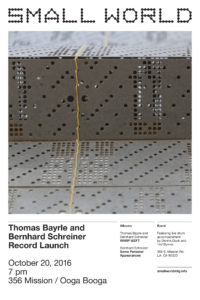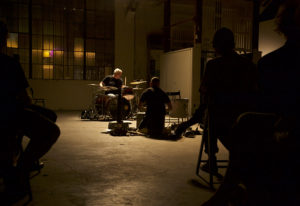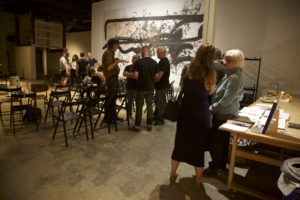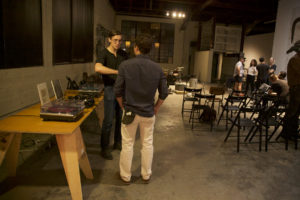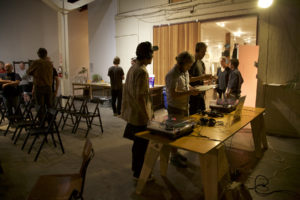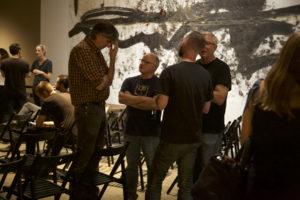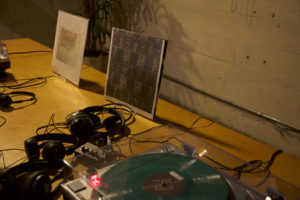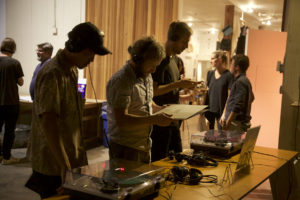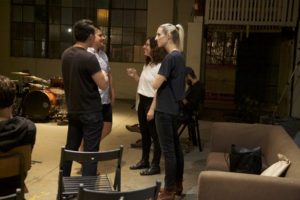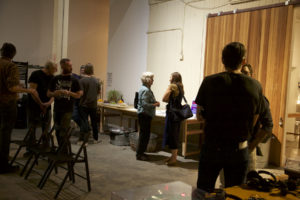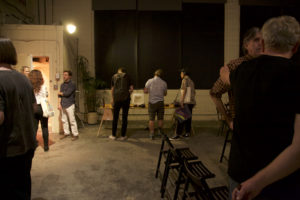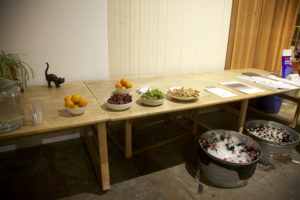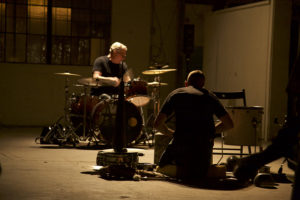Thomas Bayrle and Bernhard Schreiner Record Launch
- Thomas Bayrle and Bernhard Schreiner interviewed by Mia Laska
On the occasion of their record release event at 356 Mission, Mia Laska interviewed Frankfurt-based artists Thomas Bayrle and Bernhard Schreiner about their collaborative sound work WARP WEFT, recorded in a textile weaving factory in Schwalmstadt Trutzhain, Germany.
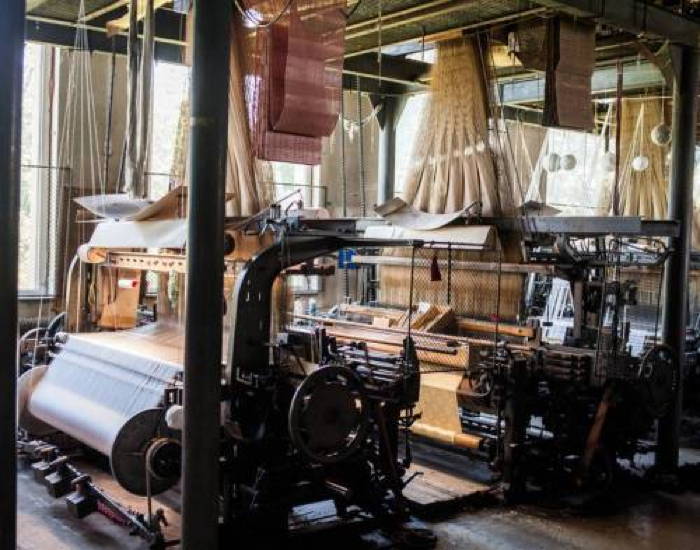
Mia Laska: Thomas, in 1958 you apprenticed at a weaving factory. Seemingly that was a formative experience that continues to inspire your practice as characterized by an obsessive preoccupation with repetition and grid structures. The weaving mill where you recorded WARP WEFT still has the exact same looms that you worked on in the 1950s. It’s the last of its kind in the whole of Germany and it almost seems like a museum. While still currently in operation, it seems likely to shut down soon. How important was it for you to make this record, to capture this particular sound before it’s not any longer available? What meaning does it have today, almost 60 years after your experience?
Thomas Bayrle: This experience – those days – helped to form my entire sight of “world!” up until this very day! The flatness / the complex binding qualities / organization of masses of similar / equal threads – being crisscrossed by complex binding qualities – helped on the one hand to serve as a pattern for richness of grids – but also to develop my feelings to “rhythm and blues”. – Weaving has occurred so early to me as an absolute philosophical and rhythmic surviving pattern / as a quality, which is reaching out far into our age…
Bernhard Schreiner: I guess we didn’t think about it in terms of documenting sounds that might possibly vanish soon from our planet, the sounds on this record are actually not what the machines might sound like if one stands next to it while weaving. Although we didn’t use any audio-effects, we did use certain recording techniques and arranged the sounds into pieces. Pieces that could be read as “music” and/or field-recordings at the same time – In my understanding/hearing they are very musical.
It’s not easy to formulate what meaning it would have today to actively listen to music or sound (if one would like to differentiate these two at all) but that’s the point with this record. I think in the first place it’s merely three pieces of music/sound – one can enjoy it or dislike it without even knowing it’s source, without even trying to find out – I go with Pierre Schaeffer’s notion of the “sound-object” somehow, even if he thought it failed. The circumstances of its recording/production, etc. is a different story, connected? yes – implicitly necessary to know about for the listening experience? no!
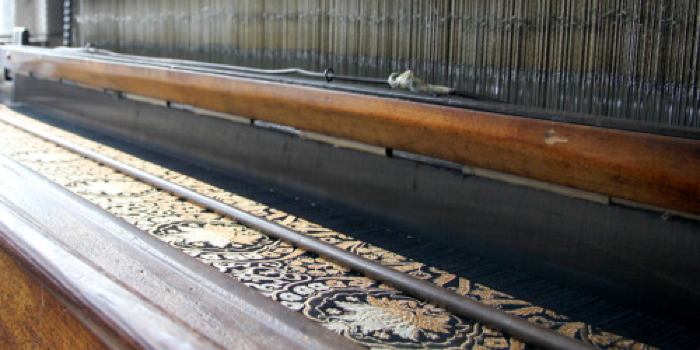
ML: During your recordings the two of you focused on specific historical machines – among them an early Jacquard loom, which is seen as a precursor of modern computing science. Its rhythmic sound is captivating and stimulating, it has a certain drama that constantly increases but then gets interrupted by sudden alterations, which all together result in several layers of dimensions. Images of an operating workshop paint themselves in one’s mind, but where do those come from? Could you please elaborate on how you recorded its sound? What are the machines actually doing during the recording? Were they in fact weaving or looming? Is there maybe even an actual piece of textile produced through the making of the record?
TB: Please let me explain the close relationship to “the mentality of analogue machine” / while Bernhard might approach it like a doctor – looking at this – those days – 100% analogue – organisms!
When we used to work in this weaving factory – those days – 9 hours per day – one had to develop an organic relationship to survive in this hell of noise / rhythm and boredom – composed by over 100 weaving Automates. –
It wasn’t possible at all – to – kind of fight against the machine<<<<<<<<<1
You would have lost immediately – fighting against it!
To survive, You had to – kind of – marry it! – built a – sort of human relationship to it…
onto 2 levels: “Rhythm” (30 years later bouncing cars / Detroit Techno / – Soundlevel Music by pure frequency – and Beat – Weft ‘n’ Warp as surviving principals.
Optical You had the beauty of boredom – looking minute by minute / hour by hour / day by day over the slowly but steady growing fabric – composed of 8000 x 8000 threads per square meter …BS: The loom you are talking about is a model from the 1940s to 1950s and it was weaving while we recorded it – a fabric, it might have been a simple but beautiful fishbone pattern, I remember it to be white or cream colored. But it’s not really important, there is no way to be able to “hear” what pattern a machine is producing at the moment. To give you an idea, I’ll talk about the piece “Shuttle (Segmenting)”, which is made from a recording of one of those early weaving machines: we set up four microphones, two condenser mics used like overheads quite far away from each other, a boundary microphone and a contact microphone, which was listening to the sounds inside the loom – sounds you would normally not hear (unless you would put your ear directly on the loom, but even then the contact mic might be more sensitive than your ear and less selective than your brain). We recorded these four microphones onto four different channels and from these recordings built the piece on the record, by editing and panning it, taking out or bringing in single channels, but always staying in sync like we recorded it.
The interruptions in the piece you are talking about are literal – the loom stops if a warp-thread breaks. Sometimes that happens quite often, sometimes it goes on for longer periods. During our recording the machine stopped repeatedly and one or more threads had to be repaired. This was done very quickly by Udo, the chief weaver, so it always continues until the next stop/break – it’s really like breaks/pauses in music but certain parts of the loom kept running during these breaks so there’s always something going on even if it stops weaving…
There’s no piece of textile connected to the recording that would have been produced for us. We took pleasure in the idea of producing pure audio. That’s the work, there’s no connected textile objects, no extensions to the LP. Of course there’s the cover, there is the sound and a physical object, the vinyl, cover, etc.

ML: Another record you released a couple of years ago is Rosenkränze (Rosaries), an almost endless, repetitive, amalgam out of human and mechanical sound. Recorded in garages and car dealer parking lots, the sounds of engines, windshield wipers, spitting exhaust pipes, and squealing rubber are mixed and collaged with the repetitive and meditative hum of the rosary prayer. In comparison the production of this album seems rather straight forward. The shifts and alterations are made directly by the machine…
TB: This record was – as with as our new record – a cooperation with Bernhard Schreiner from the beginning on!
We kind of dived into churches rosary groups with different languages and manners – car repairs shops etc. etc…
As i see it a collective quality – this humming praying ‘Än’ buzzing – connected to almost every “organic meadow” in this world –
driven all over the world – I feel like lying in a meadow – listening, smelling all sorts of sounds…..BS: Yes, there is a big difference and not only one compared to “Rosenkränze”. Actually it’s a very different approach. This time the mixing stays within the machine, not mixing two or more different sources. While “Rosenkränze” is an attempt to bring two seemingly very different worlds together to see what they have in common and how they cooperate … – with WARP WEFT we wanted to see what the looms have to tell us:
Would we discover voices or human voice like sounds buried in the machinery
Would we find musical qualities? Could we dig out something? …
And, as mentioned before, it’s not, unless with “Rosenkränze”, connected or part of another artwork – The LP is the artwork.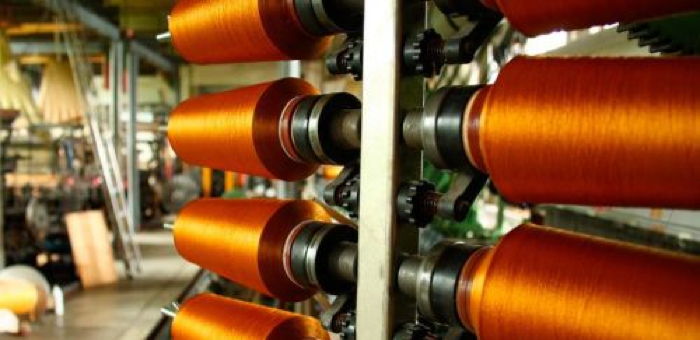
ML: Your work often reflects on the individual within socio-political, industrial, and technological entities. Thinking about the decline of the manufacturing industry in Central Europe and the fate of the mill especially – how critical is this album? Are there any political or social connotations inherent?
TB: I might be only very calm – representing a rest of all ancient ingredients in these pieces… But as I am still here – and these old monsters are still sort of alive – as well – I dare to say: mass production yes, like never before! But everything is individual! Every heartbeat only once / every weft and every warp is absolute single!
Billions of similarities – while everything exists only once – will never repeat!
So this machine and it’s sound tells me every second while it moves: This is once! I am once! and nothing will ever be the same!BS: That’s very beautiful what Thomas says here. I see it the same way. These machines are kind of like showing a very old concept that is still used a lot in a lot of different disciplines I feel. The concept of the loop which isn’t a loop if you look at it closer. A repetition that actually is a slight variation and not an exact repetition – it’s like “god is in details”, maybe god is in very very slightly varied “repetitions”, never the same and always the same at the same time.
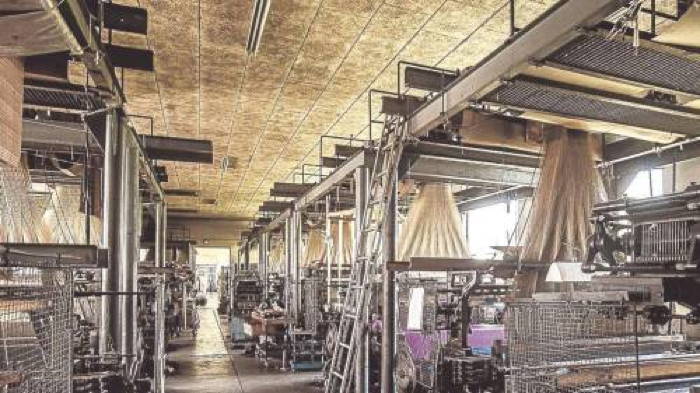
ML: Thomas, after working at the weaving factory you said that at that time you were hearing voices coming out of the machine that infiltrated your mind and body and almost drove you mad. Are you still hunted by those sounds today?
TB: …Musical sounds might reach deeper into our existence – than every other art!
In the factory I learned: never fight against a machine… try to sneak onto its Nature – via “Rhythm N Blues” – but even closer by singing sound…. All workers in this weaving mill kind of followed this! by connecting their mental and physical existences to their machines – sounds ‘n’ temperaments… they kind of loved their weaving looms.
As the weaving looms those days – were driven by electric dynamos – due to the heaviness of work – these Dynamo’s always – kind of sang… At a certain frequency their metal swing – singing – kind of shifted into some sort of a human sound… with other words – all of a sudden the Dynamo began “zu wimmern und zu jammern” – like the old ladies in my country church! did every Thursday afternoon, when they met to pray the rosary… When I associated this machine sound with this bunch of old women in the country church of my childhood: I felt anxious – not comfortable happy! and I decided: now Thomas – You have to see a doctor! You better go!*all images from the website Udo van der Kolk and show the machines recorded for WARP WEFT
Mia Laska is an Austrian art historian and writer based in Los Angeles
-
Thomas Bayrle and Bernhard Schreiner Record Launch
celebrating the release of WARP WEFT by Bayrle and Schreiner
and Some Personal Appearances by Schreiner
Featuring a performance of WARP WEFT with live drum accompaniment by Dennis Duck and Ted Byrnes
Thursday, October 20 at 7 PM
356 S. Mission Road / Ooga Booga
Tags: Bernhard Schreiner, Dennis Duck, Ted Byrnes, Thomas Bayrle

